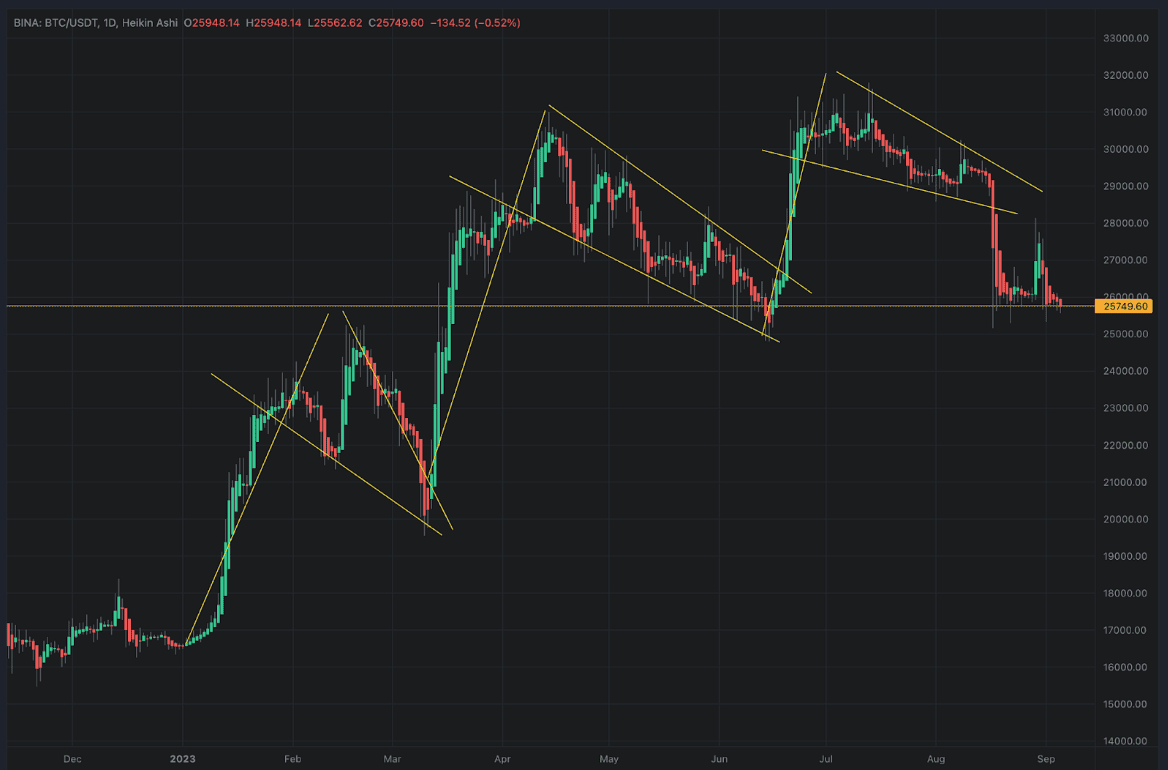Chapters
.svg)
.svg)
.svg)
.svg)
.svg)
.svg)
.svg)
.svg)
.svg)
.svg)
What Is Technical Analysis
Technical analysis examines past market data, primarily price and volume, with the purpose of predicting future price movements. Its approach is different from fundamental analysis, which centers on determining an asset's true value. In contrast, technical analysis solely focuses on market activity. To conduct this analysis, traders rely on charts as the main tools, utilizing numerous patterns and indicators to assist in making well-informed trading decisions.
How is Technical Analysis Relevant to Crypto Trading
Technical analysis has become extremely popular in the cryptocurrency market because it can be applied to short-term trading. The market's volatility makes it attractive to traders who want to make quick profits, and it can also help them navigate this fast-paced environment. It provides tools and patterns that traders can leverage to understand rapid price changes and predict future movements.
Historical Perspective of Technical Analysis
Technical analysis dates back to the 17th century when Japanese rice traders used candlestick charts to track market prices. However, it gained prominence in the West largely during the early 20th century, thanks to pioneers like Charles Dow. Dow's theories laid the groundwork for modern technical analysis and are still considered foundational.
Adaptation to Cryptocurrency Markets
Cryptocurrency is a relatively new asset class, but the principles of technical analysis remain largely applicable. The techniques have been adapted to consider the market's 24/7 trading hours, its global reach, and the unique behaviors of individual cryptocurrencies.
The 24/7 nature of the market influences the availability and frequency of data points for technical analysis. More data offers more opportunities to identify trends and make accurate predictions. Automated tools can sift through this massive amount of information in real time, allowing traders to make more timely and informed decisions.
The adaptation of technical analysis principles to the unique landscape of cryptocurrency trading has been significantly aided by trade automation tools like Altrady. These tools help traders effectively engage with a market that operates around the clock, making it easier to capitalize on opportunities and manage risks in real time, thereby offering a solution to one of the most challenging aspects of this asset class.
Key Assumptions and Principles of Technical Analysis
When using technical analysis, there are three fundamental assumptions:
- Market action discounts everything: this assumption posits that all information—public or private—is already reflected in the asset's price.
- Price moves in trends: technical analysts believe that prices move in short-term, medium-term, and long-term trends. Identifying these trends early is key to successful trading.
- History tends to repeat itself: since market psychology remains relatively constant over time, similar price patterns and trends will recur.

Importance for Cryptocurrency Traders
Understanding these principles is vital for cryptocurrency traders. For instance, recognizing that "price moves in trends" can help traders make more accurate forecasts in a market known for drastic price swings. Likewise, the 24/7 nature of cryptocurrency trading can provide more data points for technical analysis, making the "history tends to repeat itself" principle even more relevant.
Does Technical Analysis Work?
The effectiveness of technical analysis is a subject of considerable debate within both traditional and cryptocurrency trading circles. While it's important to note that no trading strategy guarantees 100% success, a substantial body of empirical research and real-world application suggests that technical analysis can, in fact, be a useful tool for forecasting short-term market movements.
Risk-Reward Calculations
One way to measure the efficacy of technical analysis is through risk-reward calculations. A typical risk-reward ratio might be 1:3, meaning a trader is willing to risk $1 to potentially make $3. By setting up trades with favorable risk-reward ratios, a trader can be wrong on several occasions and still be profitable overall. For instance, even if a technical strategy only succeeds 50% of the time, if the gains when you're right are substantially larger than the losses when you're wrong, you can still end up ahead.
Success Rates
Regarding success rates, it's important to understand that a strategy doesn't have to be successful all the time to be profitable.
Example:
Let's say a trading strategy has a 60% success rate. While this means it is wrong 40% of the time, the strategy can still be profitable if the gains from the 60% of successful trades outweigh the losses from the 40% of unsuccessful ones, particularly when coupled with a favorable risk-reward ratio.
See the following chart to see what ratios and success rates work.

Interplay with Other Methods
Many seasoned traders often combine technical analysis with other trading methods like fundamental analysis or sentiment analysis to improve their chances. No single method can provide a complete picture of market conditions, but when used wisely, technical analysis can significantly enhance your understanding of the market's short-term movements.
Cryptocurrency-Specific Considerations
In the realm of cryptocurrency trading, the 24/7 nature of the markets provides ample data for technical indicators, but it also comes with challenges such as heightened volatility and susceptibility to market manipulation. Therefore, while technical analysis can be an effective tool, it should ideally be used as part of a broader strategy that accounts for its limitations.
Conclusion
Understanding the fundamentals of technical analysis is essential for any trader, but it's particularly crucial in the cryptocurrency world, where market conditions can change in the blink of an eye. These fundamentals serve as building blocks for more advanced trading strategies, which we’ll explore in future lessons.






























